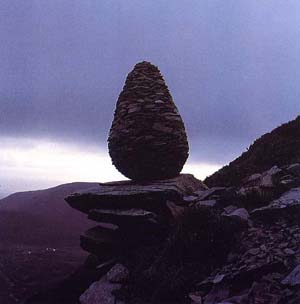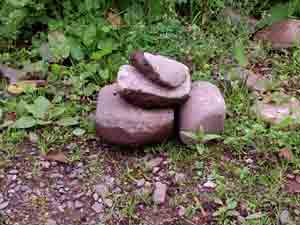The Intertidal Zone Option
 |
An egg-shaped cairn six feet tall in the valley of
Glenleith Fell, Dumfriesshire marks day becoming night. Image © Andy
Goldsworthy and found on http://www.senorcafe.com/archives/2003_11.html |
If you've opted to use the intertidal zone (good choice - congratulations) then proceed as follows! Stroll off in the general direction of one end of the beach you've landed on. If you're lucky, there'll be rocks or something to give privacy but if you can't get privacy then accept that its natural and anyway, when you've gotta go you've gotta go!
Choosing one end of the beach means that you're more likely to find privacy, if there is a rip (and most beaches will have) then it's going to go seawards and if we all use this protocol then we'll all know not to wash dishes or ourselves in the area. An alternative of course is to "designate" part of the beach as the "intertidal" zone and make sure everyone knows where it is. If another group arrives on "your" beach, it would be kind to tell them where you've designated your "intertidal".
Use your trowel to scope out a wee hole in the sand or the pebbles - or lift a suitable rock - make whatever clothing adjustments you need to (thank the Lord for drop-seat salopettes) and position yourself in an appropriate stance over the hole. I find it helps to have chosen a decent sea view and also find it helps to have checked that no yachts are about to come cruising round past the nearby headland - - - - You can always wave of course, but I find the crew tend to not wave back.
Enjoy.
Now, this is where the pocket tissues come in. I rather like the ones impregnated with stuff to help keep your runny nose from getting all raw, but that's an optional luxury. Do the wiping bit as necessary and perhaps select a wet-wipe to add the finishing touch.
At this stage, your meths and lighter is going to come in handy. Consider for a moment what we have - we have a quantity of human waste which will (after all) bio-degrade and will also serve the numerous sea beasties well. In a salt water environment, this stuff is going to get recycled fairly quickly. But the toilet paper is another matter!
Soak it with meths - apply lighter - allow to burn away - fill hole with sand / pebbles or replace rock and the deed is done! No, not quite. After all, what about your mates? Believe me, there is absolutely nothing worse than happily strolling off to a comfortable spot, producing your trowel or lifting that rock and finding you're not the first person to have exactly the same idea. Yuck.
Now, this is where you can get artistic and create some sculpture. Maybe not on the same scale as the previous one, but a small pile of stones will mark your small pile neatly and warn others. You could even just make a pile of sand, or mark an "X" in the sand.

Goldsworthy works with natural materials to produce fantastic, natural sculpture which echoes the landscapes he works in. There is one of these eggs just up the road from where I live and it's really nice to see it when driving past. If I see somewhat smaller sculptures in the intertidal zone or bushes it's really nice to know I should walk right past - - -
The SCA advice on Where to "go" in the Wilderness offers similar ideas - incidentally, it specifically advises that "squashing excrement under a boulder will slow the decomposition process and should never be done. If other techniques canít be used then a final option is to cover the excrement with a rock in such a way that the rock and excrement aren't in contact. This allows air to circulate and thereby enables decomposition."
On the theme of using natural materials, some folk will use sea-weed, grass or sphagnum moss as alternatives to toilet paper. In places like Nepal, it's common practice just to use water, but perhaps most of us aren't ready for quite that degree of closeness to nature.
Tony Laidler mailed to say "In 'Kayak Routes of the Pacific
Northwest', Peter McGee recommends use of the "intertidal flush" described
here. However, the Canadian version includes the technique of simply taking
a dump directly into the sea and relies on the sea breaking the waste down.
He advocates the use of natural toilet paper "popular types........include
stones, vegetation and snow" .
When a group of us went to the Queen Charlotte Is. to paddle a few years ago,
this type of waste disposal was advocated on the "mandatory orientation
course" that we had to take prior to setting paddle in the Gwaii Haanas
National Park Reserve. Once I had pioneered the idea, it was enthusiastically
taken up by the rest of the party. It needs a rocky coastline and obviously
the chosen spot should be some distance from your encampment. Seaweed makes
superb toilet paper - natural 'wet wipes' Since then I have used the intertidal
flush on paddling trips whenever possible."
Now wash the hands - that biodegradable salt-water lathering soap comes in handy and the job's a good 'un. Wet-wipes/antiseptic wipes work too and can be burnt if you have a fire or packed out.
If you don't fancy the idea at all, and want to take it away with you for disposal at home or at least back in civilisation, here's something worth considering - the Poop Tube - a neat way of packing out human waste, made from pvc pipe.
| Go Back to the previous page |
| Mike Buckley - September, 2004. | (Page updated
17-Feb-2009
) |
|